Sun-drenched textures, warm tones, and earthy elegance continue to redefine how modern bathrooms feel and function. This trending style strikes the perfect balance between rustic charm and clean-lined minimalism, making it ideal for those seeking both comfort and visual appeal. Whether you’re remodeling or refreshing a current space, these updated Mediterranean looks offer a fresh take rooted in timeless design principles. From arched niches and natural stone to contemporary brass finishes and terracotta palettes, each idea shared ahead helps turn ordinary bathrooms into calming sanctuaries. If you’re looking for a style-forward upgrade that doesn’t sacrifice soul, this guide is for you.
Arched Niches and Doorways
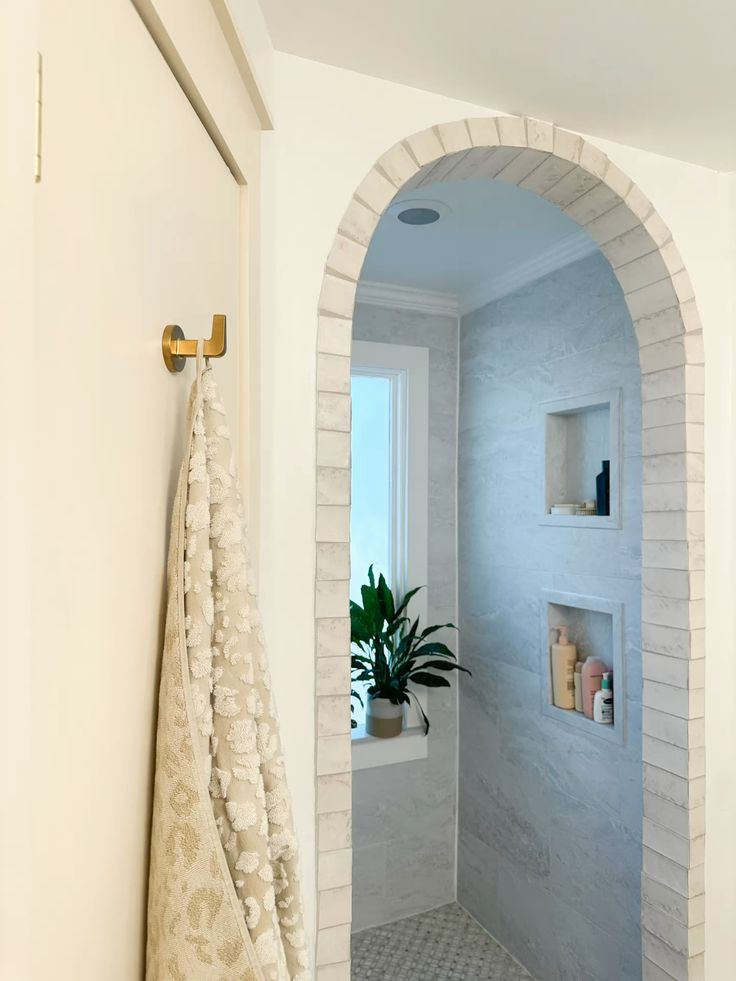
Rounded architectural elements have quietly resurfaced as hallmarks of modern Mediterranean design. Integrating arched niches and doorways introduces softness and architectural character that flat openings simply can’t achieve. These curves draw inspiration from classical Mediterranean villas while fitting effortlessly into today’s minimal interiors. They work beautifully as built-in shelving above vanities or as graceful transitions between wet and dry zones. Whether finished in plaster, stone, or limewash, arched details elevate bathroom layouts from basic to breathtaking. Their organic shape also pairs well with natural textures, from wood vanities to linen curtains. This architectural feature doesn’t just add depth; it breaks visual monotony while maintaining clean design lines. In smaller bathrooms, a single arch can shift the mood dramatically without consuming space. It’s a timeless design statement that subtly signals craftsmanship and thoughtful design. For anyone updating a bathroom in 2025, curved lines like these reflect the current move away from sterile, boxy layouts.
Terracotta and Zellige Tile Accents

Handmade textures and warm tones are making a powerful comeback, and nowhere is this more evident than in terracotta and Zellige tile applications. These traditional materials lend a sun-baked, artisan-crafted look that blends perfectly with the modern Mediterranean aesthetic. Terracotta introduces a raw, earthy warmth that can ground an otherwise minimal space. Its matte finish and natural imperfections add soul to floors or backsplashes. On the other hand, Zellige tiles, with their glazed, irregular surfaces, catch light in a way that brings subtle movement and charm to bathroom walls or niche surrounds. Whether used together or separately, both tile styles celebrate hand craftsmanship and cultural depth. The color palettes range from neutral sand and clay to rich ochres and sea greens, offering designers plenty of room to personalize. These tiles work well with contemporary elements like microcement or modern brass fixtures, creating an elegant balance of old-world texture and current-day refinement.
Limestone and Travertine Finishes
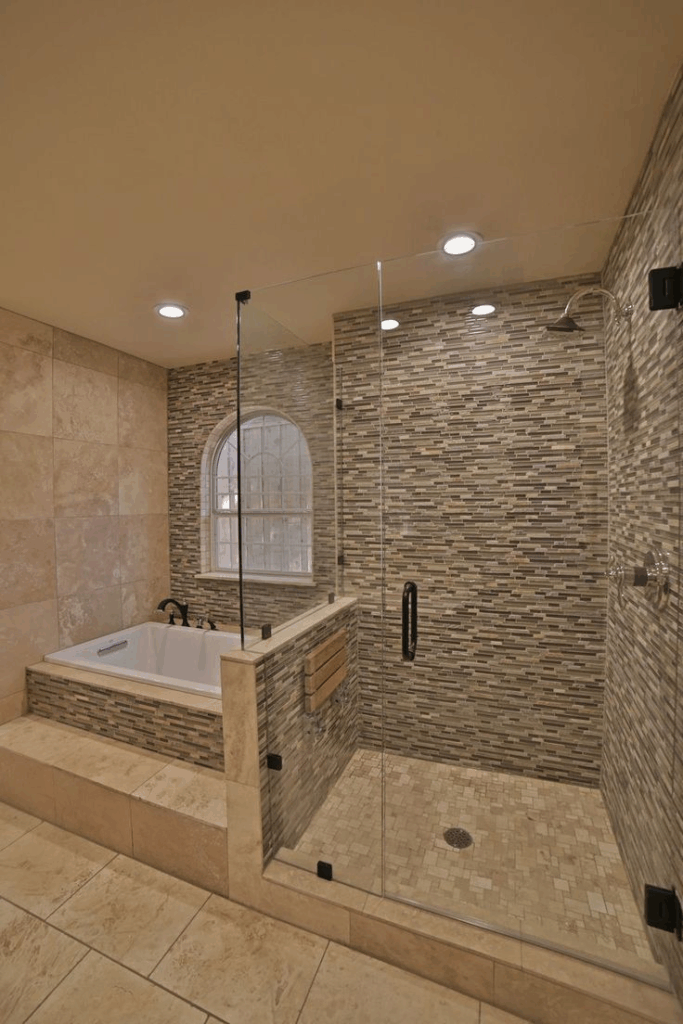
Stone elements are central to Mediterranean bathrooms, and limestone or travertine are unmatched in delivering natural elegance. These materials radiate warmth, texture, and a grounded authenticity that enhances the spa-like experience. Limestone, with its soft beige hues and fine grain, offers a minimalist look that feels luxurious without trying too hard. Travertine brings more variation and veining, perfect for adding organic movement to floors, walls, or countertops. Both materials age beautifully and lend a tactile quality that synthetic surfaces lack. They pair exceptionally with brass or iron fixtures, warm woods, and handwoven textiles. While many opt for marble in luxury settings, limestone and travertine present a more relaxed, approachable alternative rooted in Mediterranean tradition. For wet zones, honed finishes prevent slips while maintaining the stone’s raw appeal. These finishes are ideal for achieving a sun-washed, timeless vibe while staying grounded in natural materials that align with today’s sustainable design preferences.
Microcement Walls
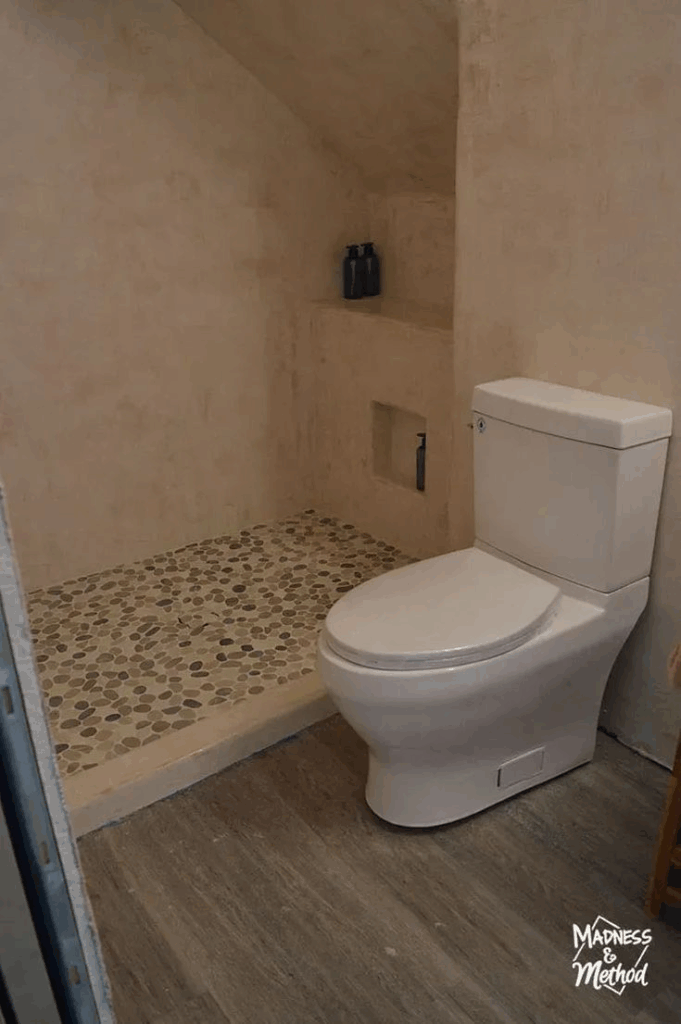
Seamless wall finishes are increasingly favored for their clean appearance and durability, and microcement stands out for its minimalist texture and Mediterranean roots. This lime-based material offers a natural, smooth surface without grout lines, making it ideal for moisture-prone areas like showers and backsplashes. The matte texture and tonal variation give it character, while the neutral hues blend well with natural stone, wood, and iron elements. It’s also waterproof when sealed properly, allowing for monolithic wall applications that look custom and high-end. Unlike tile or paint, microcement adds depth through its hand-applied texture and subtle imperfections. It reflects the understated elegance of Mediterranean style while also delivering a contemporary aesthetic aligned with today’s spa bathroom trends. Whether used in a soft sand tone or deeper taupe, this finish contributes to a grounded, relaxed atmosphere. Its versatility allows it to cover not only walls but also sinks, tubs, and even floors for a cohesive look.
Natural Wood Vanities

Warm wood tones play a crucial role in softening the hard surfaces commonly found in bathrooms. Natural wood vanities, especially in walnut, white oak, or reclaimed pine, are staples of the modern Mediterranean look. These pieces bring in tactile warmth while anchoring the space with grounded elegance. Rather than polished or lacquered finishes, raw or lightly sealed wood surfaces help highlight grain patterns and imperfections—details that reflect craftsmanship and authenticity. Integrated drawers with subtle pulls or open shelves beneath offer both utility and visual balance. Pairing a wood vanity with a stone sink or handmade ceramic basin enhances the organic sensibility central to Mediterranean design. When styled with neutral linens, vintage mirrors, and aged brass faucets, the wood vanity becomes the focal point without overpowering the space. It’s an easy update that brings nature into the bathroom while aligning with both rustic and refined interpretations of this trending design style.
Wrought Iron Fixtures
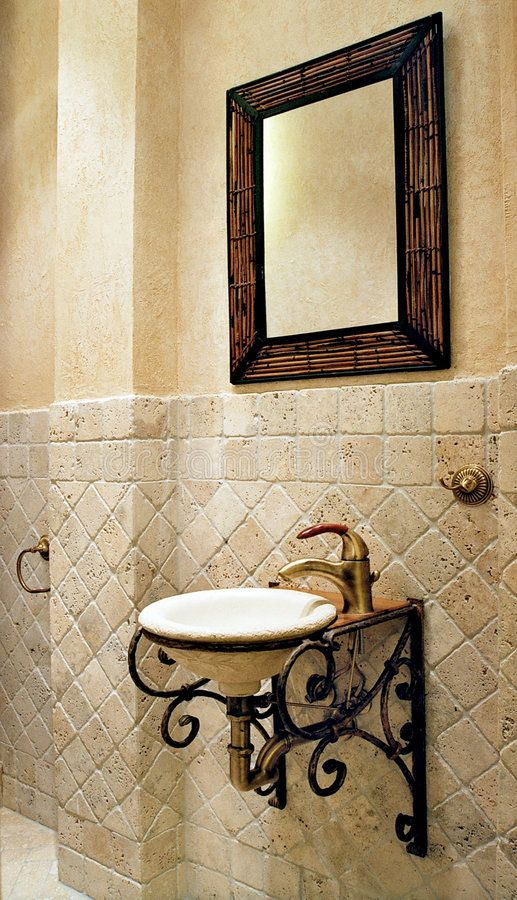
Durability and artisan detail meet effortlessly in the use of wrought iron for bathroom fixtures. This material is deeply tied to Mediterranean architecture, known for its ability to deliver structure, contrast, and historical charm. Today’s designs often use matte black or patina-finished iron for mirror frames, towel bars, or shower enclosures—each piece serving as functional art. Iron works particularly well against neutral walls or textured surfaces like microcement or stone, creating visual tension without disrupting harmony. Unlike polished chrome or nickel, wrought iron brings warmth and depth without shine, allowing other materials to breathe. Its presence also nods to the handmade legacy of Mediterranean style, reinforcing authenticity in the smallest of design details. From arched sconces to vintage-inspired handles, iron adds tactile richness that supports the room’s balance between rustic and refined. For modern homes embracing global influences, it’s an effortless way to inject story and structure into a bathroom.
Step-Up Bathtubs
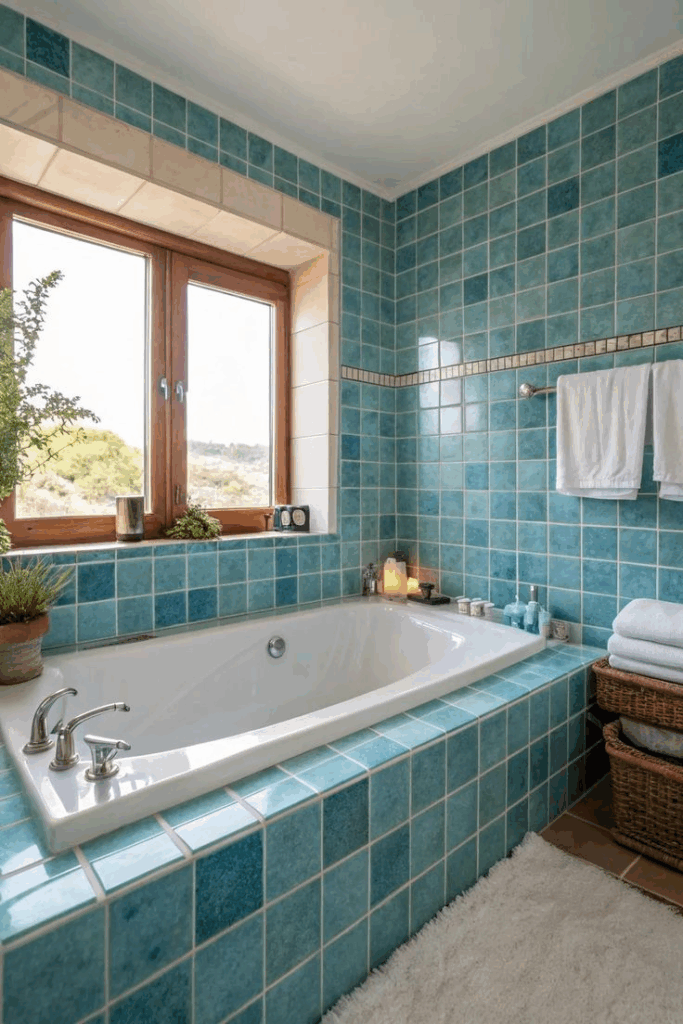
Tub platforms are increasingly favored in Mediterranean bathroom layouts, adding architectural depth and old-world character. These designs echo the bath culture of Southern Europe, where soaking was both a ritual and a retreat. Raising the bathtub on a tiled or stone step introduces dimension, separates zones, and subtly emphasizes luxury. This approach also allows for creative floor patterns or lighting beneath the step for ambient glow. When paired with textured finishes like travertine or lime plaster, the overall look becomes both inviting and sculptural. Step-up bathtubs work especially well in larger spaces but can also define alcoves in smaller ones. Framing the tub with arched niches or iron lanterns adds authenticity, while linen curtains or carved wood screens can introduce privacy with artistry. Beyond aesthetics, this layout also improves water drainage and makes cleaning easier. For homeowners seeking a spa-like Mediterranean feel, this small architectural tweak delivers high visual payoff.
Tile Drenching
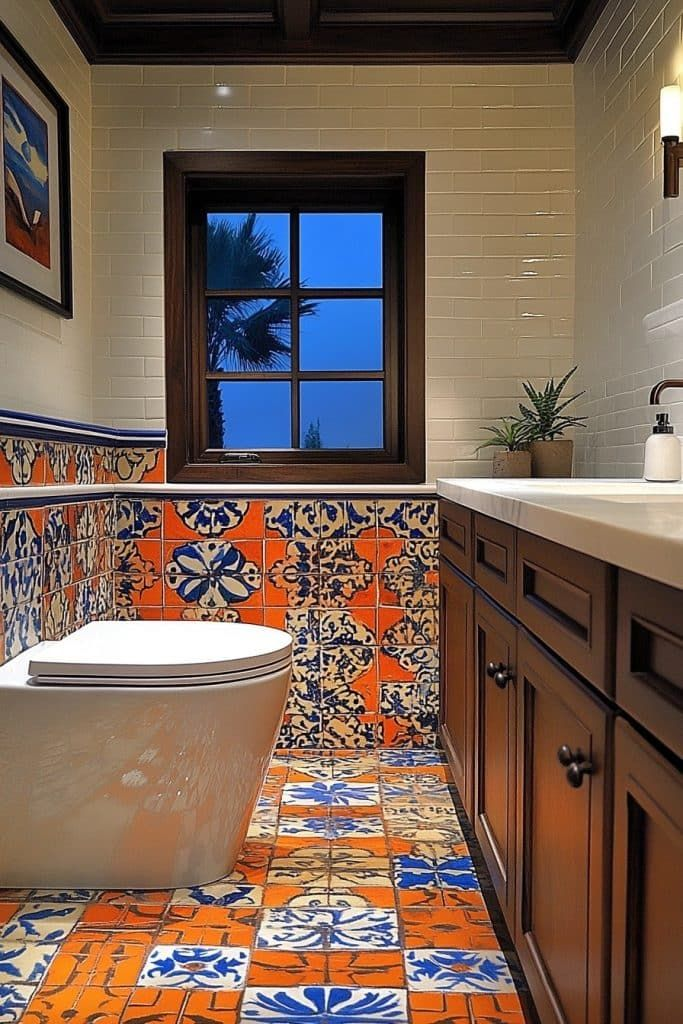
Designers are leaning into immersive surface treatments, and tile drenching stands at the forefront of that movement. By continuing the same tile from floor to ceiling—often even onto vanities or tubs—the bathroom takes on a cohesive, monolithic appearance that reads high-end and intentional. This technique is particularly effective with handmade or textured tiles like Zellige or terracotta, which reflect light irregularly, adding natural variation despite the uniform color. Tile drenching creates a cocooning effect, ideal for those wanting a sanctuary feel without relying on heavy decor. It also visually expands smaller bathrooms by eliminating horizontal breaks. In a Mediterranean context, this approach honors traditional materials while adopting a more contemporary silhouette. Warm clay tones, sage greens, or sand-colored neutrals work especially well for this treatment. While grouting is minimized for aesthetic flow, sealed finishes ensure moisture resistance. The result is a deeply atmospheric space that feels carved, grounded, and enduring.
Organic Textures

Visual warmth often begins with how a space feels, and nothing delivers that better than organic textures. From raw plaster walls to woven baskets and linen curtains, Mediterranean bathrooms are anchored by tactile elements that soothe the senses. These textures provide contrast to harder surfaces like tile or metal, offering a layered, lived-in feel that doesn’t rely on clutter. Hand-troweled finishes, rough-cut stone, and unglazed ceramics embody imperfection in the best way—each surface carrying evidence of its origin. Rattan stools, jute rugs, and even weathered wood accessories extend the textural palette without overwhelming the aesthetic. This use of authentic, touchable materials not only adds visual complexity but aligns with the Mediterranean ethos of quality over polish. Such textures invite relaxation and connection to nature, two essential elements in today’s bathroom design. Whether the space is large or compact, this grounded approach fosters a sense of escape without straying from practicality.
Earthy Color Palettes
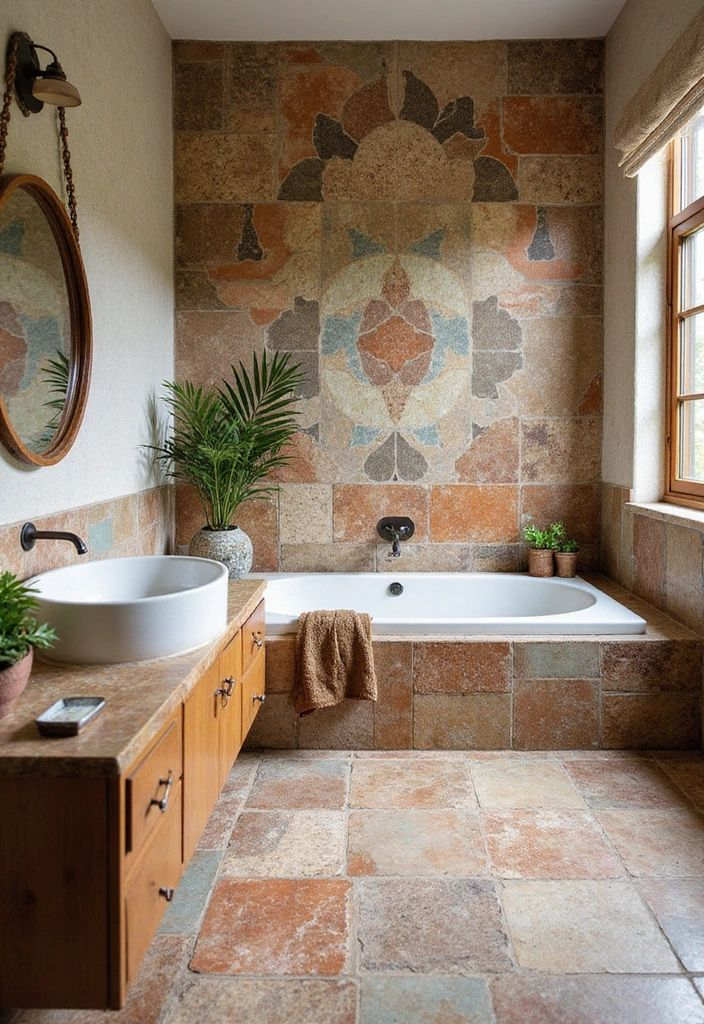
Color choices rooted in nature play a significant role in establishing the mood of a Mediterranean bathroom. Instead of stark white or cool gray, designers are gravitating toward sunbaked tones—think sand, clay, sage, ochre, and bone. These colors create visual warmth while connecting the interior space to its outdoor surroundings, a key principle in Mediterranean design. Whether applied through painted walls, textiles, or ceramics, these shades foster a grounded and serene environment. They’re especially effective when combined with raw materials like terracotta, aged wood, or limestone. Muted palettes also allow more textured or patterned surfaces to shine without clashing. Layering tonal variations of the same color family can add depth without relying on contrast. In smaller bathrooms, lighter earth tones help maintain openness, while deeper hues like rust or olive green can provide intimacy. This palette serves both visual and emotional calm, making it ideal for spa-inspired spaces rooted in nature.
Integrated Greenery

Bringing nature indoors is more than a trend—it’s a return to how Mediterranean homes have always interacted with the environment. Integrated greenery in bathrooms offers a gentle connection to the outdoors, even in urban homes. Recessed planters in shower walls, built-in niches for cascading pothos, or floating wood shelves holding olive branches add softness and vibrancy without clutter. Plants such as eucalyptus, snake plants, or trailing ivy thrive in humid spaces and introduce gentle movement and color against neutral backdrops. The key is subtlety—greenery should feel like a design element, not an afterthought. Pairing terracotta pots with limewash walls or brass wall planters with microcement textures heightens the sense of harmony. Greenery also softens harder architectural lines, making the space feel fresher and more relaxed. In Mediterranean-style design, plants aren’t just decorative—they represent life and continuity, enhancing emotional wellness while supporting a natural, grounded environment perfect for daily rituals.
Minimalist Lighting
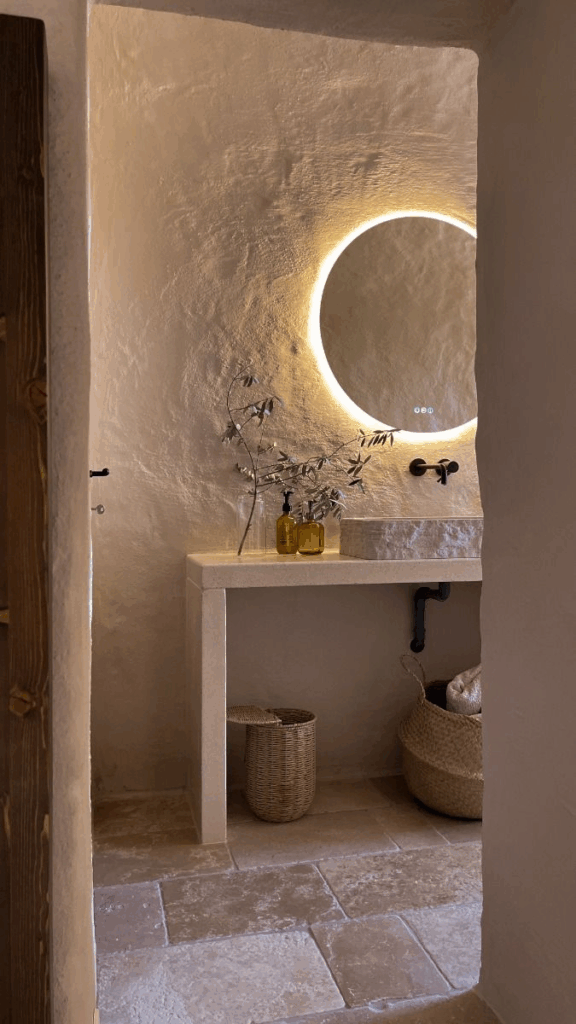
Lighting in Mediterranean bathrooms tends to be both intentional and understated. Rather than spotlighting with overhead glare, design favors wall-mounted sconces, recessed lighting, or lantern-style fixtures that emit a soft, diffused glow. Brass or wrought iron bases are popular choices for their patina and texture, especially when paired with linen or frosted glass shades. The goal is warmth, not brightness—light should flatter textures and surfaces without overpowering the room. Placing sconces near arched mirrors or over vanities ensures function while preserving ambiance. In showers or alcoves, integrated LED strips tucked behind niches or beneath shelves offer targeted illumination that blends into the architecture. This type of lighting design reflects the Mediterranean principle of balance—merging utility with artistry. By focusing on quality of light over intensity, it helps transform everyday routines into calming rituals. When thoughtfully layered, minimalist lighting becomes a quiet but essential feature of an emotionally inviting space.
Curved Shower Enclosures
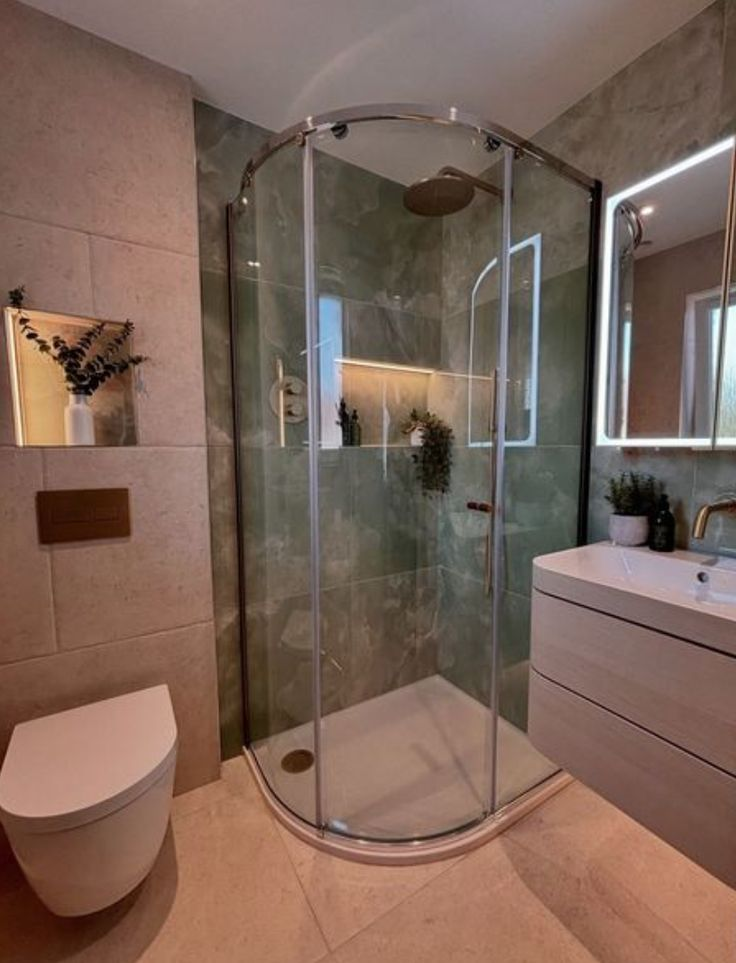
Angular lines are giving way to fluid curves, especially in shower design. Curved enclosures introduce softness into bathrooms while optimizing layout and enhancing movement. Frameless glass panels bent into gentle arcs offer a modern solution rooted in the classic architectural language of Mediterranean spaces. These rounded forms echo arched doors and niches, contributing to continuity throughout the design. The curved layout also helps soften tight corners, especially in smaller bathrooms where space must be efficient but still inviting. Rather than boxing in the shower area, curved glass helps light travel more freely, enhancing the sense of openness. This design pairs well with warm tile tones, stone floors, and organic materials like wood and rattan. Finishes in black iron or brushed brass further emphasize the Mediterranean influence without distracting from the overall fluidity. It’s a design-forward solution that marries elegance with functionality, delivering beauty without sacrificing day-to-day comfort or spatial clarity.
Vintage-Inspired Hardware
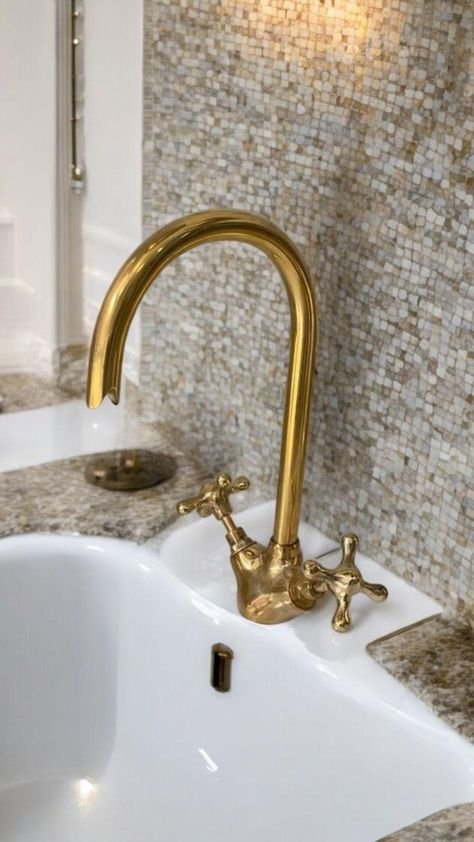
Finishing touches often carry the most weight in defining a bathroom’s style, and vintage-inspired hardware brings in soul and substance. Drawn from traditional European design, these pieces evoke timelessness with their intricate shapes, aged finishes, and weighty feel. Think cross-handle faucets in antique brass, hammered metal knobs, or detailed escutcheons on drawers and doors. These touches contrast beautifully with otherwise minimal layouts, offering a nod to history without feeling outdated. Hardware like this works particularly well against organic surfaces—stone countertops, plaster walls, and natural wood cabinetry. Patina is a plus, not a flaw; it signals character and longevity, aligning with the Mediterranean design philosophy of aging gracefully. Swapping out basic hardware for more storied alternatives is a cost-effective way to upgrade a space instantly. For those pursuing a look that feels curated rather than showroom-like, vintage-inspired details add authenticity, making even the smallest elements feel considered and timeless.
Open Shelving with Artisan Decor
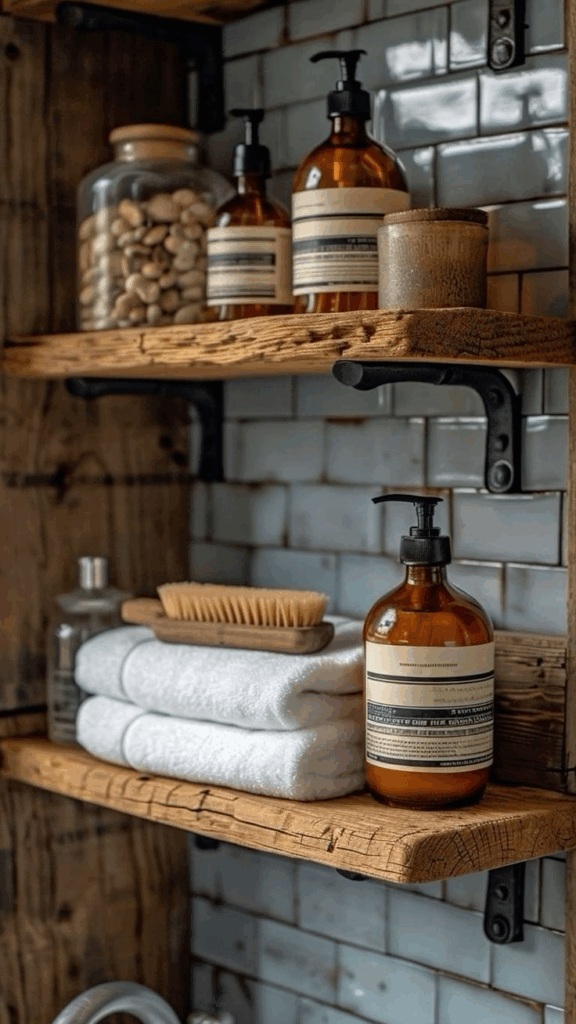
Personalization comes to life on open shelves, where decor becomes part of the design story. In Mediterranean-style bathrooms, open shelving is more than functional—it’s a canvas for displaying handmade and meaningful pieces. Think hand-thrown ceramics, carved soap dishes, woven baskets, or vintage glass bottles. These pieces add narrative and texture, often sourced from local markets or with stories attached. Using reclaimed wood for shelves introduces warmth, especially when set against stone or plaster walls. Spacing and styling are crucial—too many items overwhelm the effect, but a few curated pieces create charm and visual rhythm. Shelves can also house everyday essentials like rolled towels or apothecary jars, blending beauty with utility. This style of decor aligns perfectly with Mediterranean values—craftsmanship, intention, and natural materials. It’s a reminder that design isn’t just about surfaces but about how a space feels when you live in it. Open shelving, done right, delivers both.
